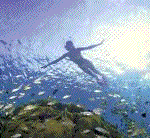Home :: India-Adventure Tours :: Scuba Diving And Snorkeling
SCUBA DIVING AND SNORKELING
One of the greatest adventures in life can be to explore the totally unknown and unexplored world under sea. The joy of floating inside the sea like a fish where every creature is your friend and every new sight is a discovery can be immense. In addition, the sheer thrill of watching the rich flora and fauna of the sea in their natural habitat is unparalleled.

The curiosity to know the underwater world of the sea is not a new phenomenon for human civilization. We have so many stories from the epic Ramayana describing the world beneath the sea when Hanuman was crossing the sea to reach Lanka. The origin of many mythical characters and objects are related to the sea. There is a legend about Samudra Manthan (churning of the ocean) that tells us that the sea was churned around a hill known as Meru with a snake (Sheshnag) around it. One end of the snake was pulled by the gods while the other end was pulled by the demons. Many amazing things came out of this exploration-an elephant called Airavata that became the property of Indra, a tree called Kalpavriksa that could grant anything, a cow known as Kamdhenu that gave milk everyday, the Goddess of wealth Lakshmi, the god of Ayurveda Dhanawantari, the Visha (poison), and Amrit (nectar).
Scuba diving and Snorkeling as sports came with the Europeans who saw the vast expanse of the Indian coastline. Besides, many Indians who experienced this unique adventure also brought with them a new and exciting option for their fellow countrymen.
Stretching many thousand kilometers, the Indian coastline spans the mighty waters of the Arabian Sea, the Indian Ocean and the Bay of Bengal. Dotted with the finest beaches, cliff promontories, mangroves, backwater, jewel-like island groups and marine life, there are wide diving possibilities. While there are many popular easily accessible sites, many more can be explored which are not at all known.
The sight of the smashing waves creating foaming breakers on the coral reef, which enclose azure lagoons whose crystal clear waters wash the fine grained white sands of the palm dotted low islands, is one of the few marvels of God's creations left untouched by the encroaching hands of industrialization and progress.
The underwater city is a unique and diverse collection of colorful and weirdly patterned sea animals. Corals take pride of place in these reef cities. Rich in variety and color, the thousands of types of corals range from tall sea fans to small hydroids, from languidly waving sea anemones to glassy jellyfish.
Danger there is, but only enough to add to the sense of adventure and thrill. This fun is multiplied many times over as you don the scuba gear. This gear has been especially devised for the deep sea diver and gives an opportunity for thrill and adventure unparalleled and unimagined by ones who think of the sea as nothing but a large saltwater lake.
India is fast becoming the adventure tourism destination of the world; and scuba diving and Snorkeling as well as other water sports are going to be an integral part of this. If you have not had adventure in India, you do not know what adventure is all about.
Scuba diving and Snorkeling are water sports.
LEVELS OF DIFFICULTY
Levels of difficulty for scuba diving vary from the person who enjoys it as a recreation to the one who takes it as profession.
You can start on the experience level and go up in the ladder from there. Next on the list will be scuba diver certificate, which will make you eligible to go on the next scuba diving under the supervision of a master diver. The scuba diver certificate also leads to the advance open water certification. Then you move on to specialized levels like underwater photography, fish identification and similar explorations. After getting your open water certificate, you can go up to be an adventure diver. At this level, you will have to go for at least three of the 16 specialized dives. The next step would be getting an advanced open water certificate. The minimum eligibility is attaining 15 years of age with an open water certification. You will be needed to complete at least five of the specialized dives available. Medic first aid is a prerequisite for the advanced level programs such as advanced plus rating and rescue diver. It is a basic program in basic cardiopulmonary resuscitation (CPR) and emergency care. This program is open for divers and non-divers both.
The next on the list is the rescue diver program for which you are needed to attain the age of 15, should have advanced open water diver or advance plus and medic first-aid certifications. This certification also makes you ready to be a master scuba diver, the first stage in your going pro. The master scuba diver certification is the ultimate goal of a recreational scuba diver. For this, you should attain the age of 12 years and must have completed any open water, advanced open water, medicaid, and rescue diver programs. If you are a professional having attained your assistant instructor or divemaster certifications and five specialty dives, you are eligible to go for master scuba diver program.
As a pro, you will be first required to go through all the steps as a recreational scuba until the stage of scuba divemaster. From this point, you can go on to become an assistant instructor/instructor, specialty instructor/first-aid medic instructor, master scuba dive trainer, staff instructor, medic first-aid instructor, master instructor, and finally a master director.

PHYSICAL REQUIREMENTS
Not much is demanded to participate in scuba diving and Snorkeling programs. You needn't be a heart patient, should not have high or low blood pressure, better if you are not an expectant mother. Better if you can check with your physician. The minimum age requirement is 10. If you're between 10 and 15, you receive a junior open water diver certification. 10 and 11 year old junior open water divers must dive with a certified parent, guardian or a professional to a maximum depth of 12 m (40 ft). Twelve to 14-year olds should dive with a certified adult. When you turn 15, you can upgrade your junior certification to a regular open water diver certification.
NECESSARY EQUIPMENT
Wet suit (breath depending on the water temperature), fin, tank, mask, snorkel, a knife, a pair of leather or canvas gloves, underwater flashlights for night diving, dive tables, and dive watch.
In many places in India, including Lakshadweep and Andamans, equipment for scuba diving are available and that also at reasonable prices. You need not purchase the equipments as an amateur as most of the diving resorts and schools can provide them to you on rent, if you can show a diving certificate.
BEST TIME
Any time is the best time for scuba diving and Snorkeling in India. Due to the vastness of its coastline and different geographical regions coming it, India has multiple climatic conditions working at the same time. It makes the country, perfect to visit in any season.
MAJOR DESTINATIONS
Andaman and Nicobar Islands and Lakshadweep are the best places to enjoy Scuba Diving and Snorkeling in India. In Andamans, one can enjoy the under-water marine life and view the rarest varieties of corals by Snorkeling in the Mahatma Gandhi Marine National Park, Carbyn's Cove Tourism Complex, Havelock and other islands on all days from dawn to dusk depending on the weather. Diving in Andaman waters offer a fascinating world of under-water marine life, varieties of colorful fish, rare coral reefs, mysterious remains of sunken ships, etc. All these can be explored through scuba diving.
Lakshadweep is fast becoming water sports capital of India and especially of the underwater sea sports. With its large coastline, coral islands, and great variety in the marine life, Lakshadweep can be termed as the most unfrequented of fascinating scuba diving destinations in the country.
THE PROCESS
The whole process of scuba diving consists only four or five basic steps that have to be taken care of. The first step is to check that all your underwater gears are in the proper condition. Get into your diving gears starting with the facemask to the fins. Having your nose inside the mask properly is important for you have to sometimes blow through the nasal passage to clear the mask. The nose also has to be blocked by the divers to enable them to 'pop' their ears, which help clear the pressure from your ears. Choose a flipper that does not hurt your feet. The next step is to load weights into your belts to take you down. After that, you can get into your jacket with the gas cylinders. When you are through with your gears, this is the time go down in the sea. But, before that don't forget to look for your support line attached to you. Once inside the sea, the whole world of sea and its residents are your friend and behave with them properly. Any misbehaving with them can cost you more than you bargained for. Take care of all the safety measures already described to you. As the pressure of the water increases with the depth, you can have pain in your ears. Some exercises are recommended by the trainers to be safe from this and most useful is "popping" your ears whether you are going down or coming up.
PRECAUTIONS
1. Diving today is as safe as any other active sport but trying to dive without first learning something about the equipment and how to use it is as foolish as trying to drive a car without first learning something about the car.
2. Anybody trying his hands at scuba diving and Snorkeling must not only be fully aware of the dangers the protruding coral rocks present but should also be able to avoid them. It needs a trained eye to spot out these clusters because often they merely appear as mere dark patches on the emerald water; and such patches are often created by the small flecks of cloud that almost always dot the sky.
3. All dives in the shallow lagoon are great fun provided you have a glass mask and a snorkel tube. While the latter provides a vent for breathing, the glass case is for enabling you to see clearly through the water.
4. You are also needed to be safe from shark, octopus, or jellyfish. When in any problem, go for the medical attention quickly and inform the others if you are in a group.
5. Undersea environment is in the danger of overexploitation and
there are reports of many corals being damaged due to high pressure.
Please make sure that you are not contributing to this damage. You
are also expected to respect the local cultures and traditions.



